Brighten your urban jungle with 14 purple-and-green leaf houseplants—perfect for every plant parent, whether you’re just starting out or honing your hobby.
From easy, set-and-forget favorites like the Wandering Dude to more involved beauties like the Rose Painted Calathea, you’ll find clear, city-friendly tips for each level of green-thumb prowess.
Scroll on to meet your next purple leaf roommate!
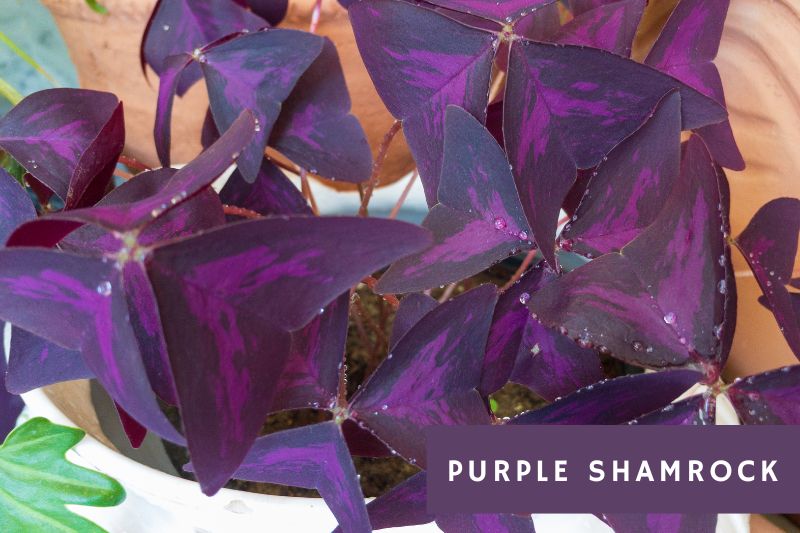
Purple Shamrock
The Purple Shamrock is a standout purple leaf houseplant, its trio of velvety, plum-colored leaflets fanning like tiny parasols—and adding instant drama to any tabletop or windowsill.
As a bulbous perennial, it follows a gentle growth rhythm: new shoots rise from underground bulbs, forming neat rosettes that unfurl at first morning light and softly fold at dusk, bringing living movement to your space.
This purple leaved houseplant thrives in bright, filtered light and a simple soak-and-dry routine.
Key Features:
- Butterfly-shaped leaves
- Nighttime folding
- Dormant bulb cycle
- Drought tolerant
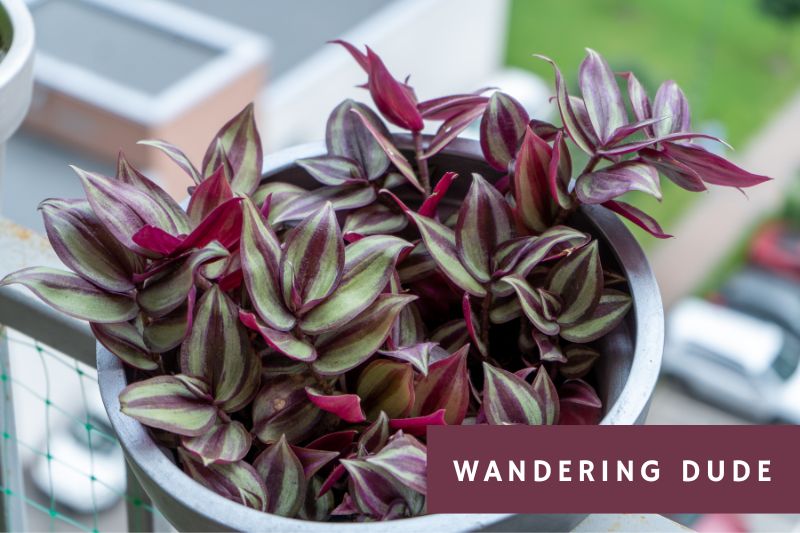
Wandering Dude
The Wandering Dude flaunts lance-shaped leaves banded in purple and silver, spilling like ribbons from any hanging basket.
This fast-growing trailer can stretch 2–3 ft in a single season—perfect for filling empty spots with nonstop color and movement.
Keep it in bright, indirect light and water when the top inch of soil dries (about once a week). It’s frost-tender (USDA 9–11) and can be invasive outdoors, so stick to containers or check local guidelines.
Key Features:
- Purple-silver stripes
- Rapid trailing growth
- Easy propagation
- Hanging basket habit
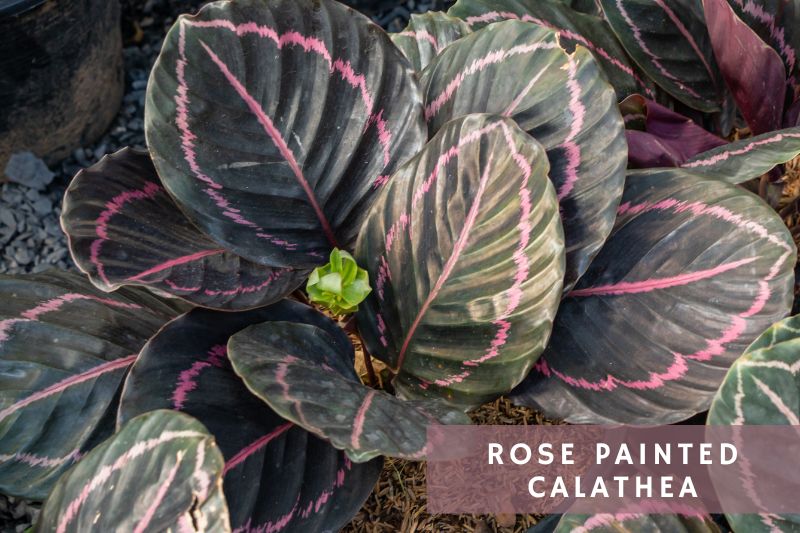
Rose Painted Calathea
The Rose Painted Calathea displays large, deep green leaves streaked with soft pink banding and flushed purple underneath—an eye-catching statement in any indoor garden.
This clumping perennial forms neat rosettes, slowly filling out into a lush mound. Its architectural habit adds texture and depth, making it perfect for a dedicated plant shelf or grouped on a humidity tray.
To keep its patterns crisp, give it bright, indirect light and maintain evenly moist soil. Boost humidity with regular misting or a humidifier—this beauty won’t tolerate dry air.
Key Features:
- Pink leaf variegation
- Purple leaf undersides
- Humidity lover
- Clumping rosette form
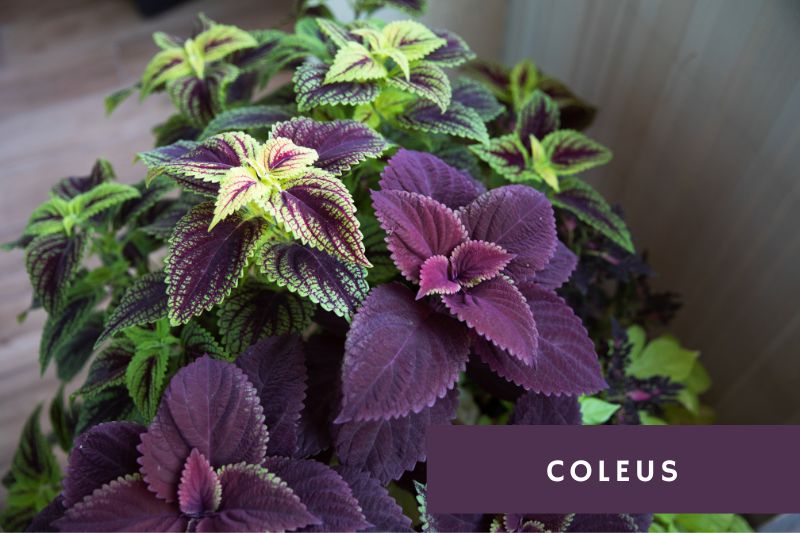
Coleus
Coleus dazzles with its blazing mix of purple and green leaf patterns, instantly transforming any corner into a living rainbow. Its bushy, mounded habit works equally well in a pot on your shelf or spilling from a hanging planter.
A true green and purple leaf plant chameleon, it tolerates bright, filtered light to partial shade—indoors or out—so you can find the perfect spot without fussing over precise placement. Pinch back growing tips to encourage fuller growth and more vibrant color.
Water when the top inch of soil feels dry (usually every 5–7 days). Keep soil evenly moist but never waterlogged. Snap off stem cuttings and root them in water or soil for an endless supply of new plants.
Key Features:
- Wide range of colors
- Shade tolerant
- Easy propagation
- Indoor/outdoor use
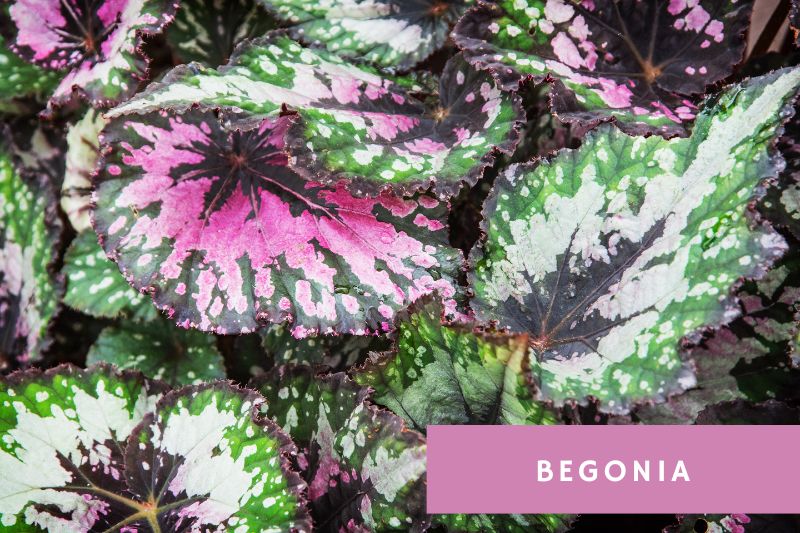
Rex Begonia
Rex Begonia is one of the most striking purple leaf houseplants, its large, asymmetrical leaves splashed with swirls of plum, emerald, and silver—an instant art piece for your indoor jungle.
This clumping perennial forms tight rosettes that slowly expand, creating a lush carpet of patterned foliage. It prefers bright, indirect light—too much sun will fade its vivid colors, while too little can slow its growth.
Keep it in a well-draining mix and water when the top inch of soil begins to dry. Aim for evenly moist (not soggy) conditions, and boost humidity with a pebble tray or occasional misting to keep leaf edges crisp.
Key Features:
- Artistic foliage
- Silver-plum swirls
- Indirect-light fan
- Air-purifying power
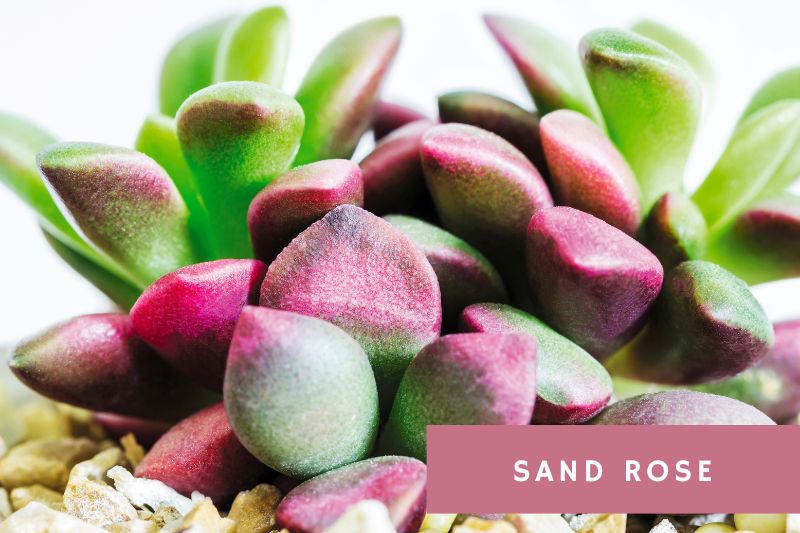
Sand Rose
Sand Rose is a charming succulent with plump, teardrop leaves that shift from soft green to dusky purple—and glow coral-red under bright sun. Its rosettes stay compact, making it a perfect desktop companion or shelf accent.
This slow-growing gem thrives in bright, indirect light indoors and full sun outdoors when temperatures stay above 50°F (10°C). In lower light you’ll see more green, but a sunny spot will coax out those sunset-red tones.
Water sparingly: let the soil dry completely between drinks, roughly every 2–3 weeks. Use a well-draining cactus mix and protect from frost—this succulent isn’t winter-hardy, but in warm months it adds year-round interest.
Key Features:
- Sunlight color pop
- Minimal-water care
- Indoors/outdoors use
- Frost-sensitive
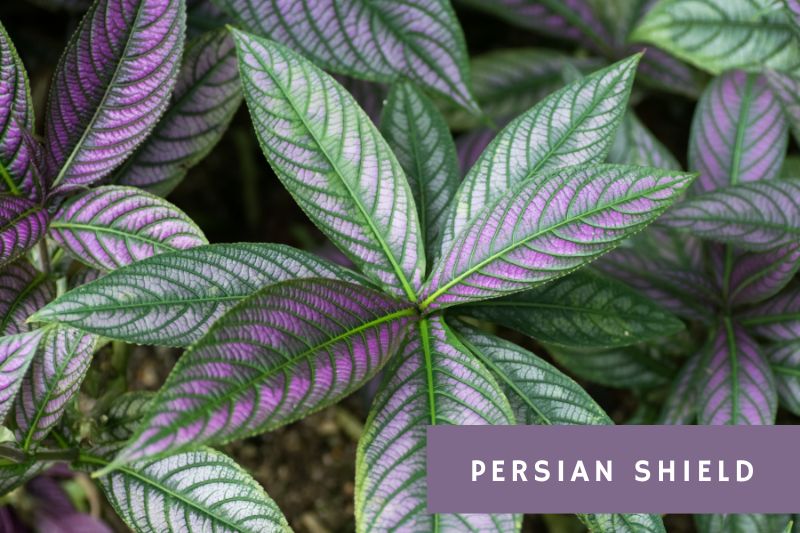
Persian Shield
The Persian Shield dazzles as a purple and green plant, its metallic-purple leaves veined in emerald green that shimmer with every shift of light.
This upright beauty forms a 2–3 ft bushy clump—ideal for a striking backdrop on a shelf or tabletop. Pinch back tips and prune leggy stems to keep its form full and lush.
A true tropical diva, it craves warm, humid air and bright, indirect light. Keep soil evenly moist (never soggy) and mist or use a pebble tray to sustain its radiant sheen all season long.
Key Features:
- Iridescent leaf sheen
- Emerald vein contrast
- Upright bush form
- Heat & humidity lover
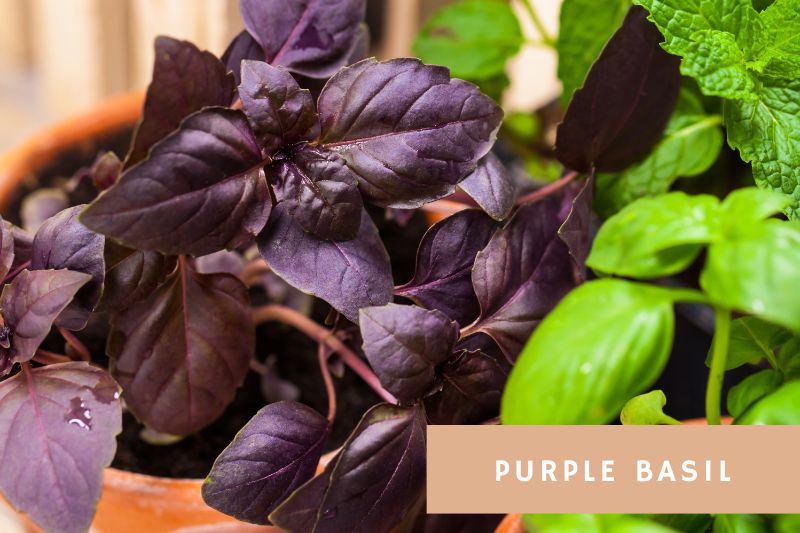
Purple Basil
Purple Basil brings a burst of color and aroma to your indoor garden, with its rich purple leaves and reddish-tinged stems adding instant visual and sensory appeal.
As an annual herb, it grows into a lush, bushy mound—pinch back the tips regularly to encourage fuller branching and more leaves to harvest. Expect strong, fragrant foliage you can snip straight into salads, pesto, or cocktails.
This sun-loving purple and green leaf plant thrives in bright, direct light; keep soil evenly moist and feed every few weeks with a balanced fertilizer. Harvest leaves often to prevent flowering and extend its productive season.
Key Features:
- Deep purple foliage
- Kitchen-ready scent
- Sun-seeking growth
- Fast leaf production
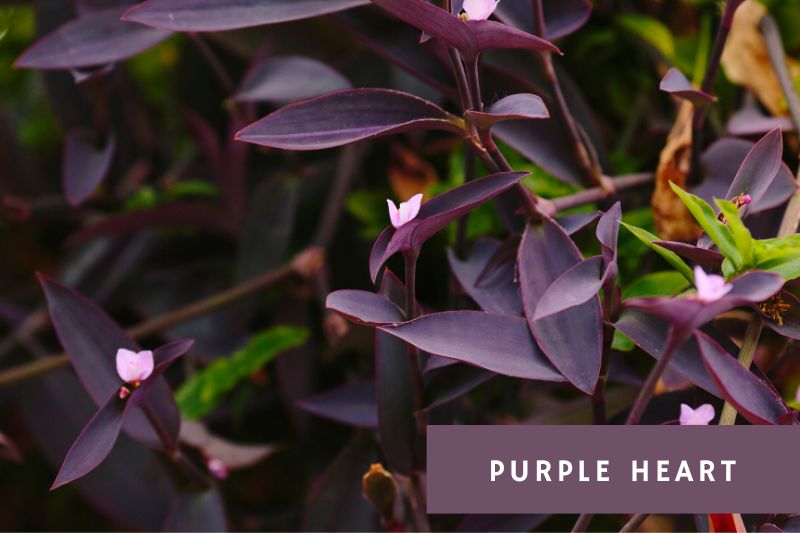
Purple Heart
Purple Heart makes a bold statement with its strap-like leaves in deep plum, each stem forming a vibrant carpet or cascade—perfect for hanging baskets or as a living ground cover.
This fast-growing trailer sends out runners that root at the nodes, filling empty space in no time. Its dramatic foliage contrasts beautifully against green companions, adding instant texture and color.
Place it in bright, indirect light (morning sun is fine) and water when the top inch of soil dries. Though drought-tolerant once established, avoid soggy pots—and note it can be invasive outdoors, so contain it in planters or watch its spread.
Key Features:
- Deep plum foliage
- Runner-form habit
- Fast-spreading cover
- Invasive alert
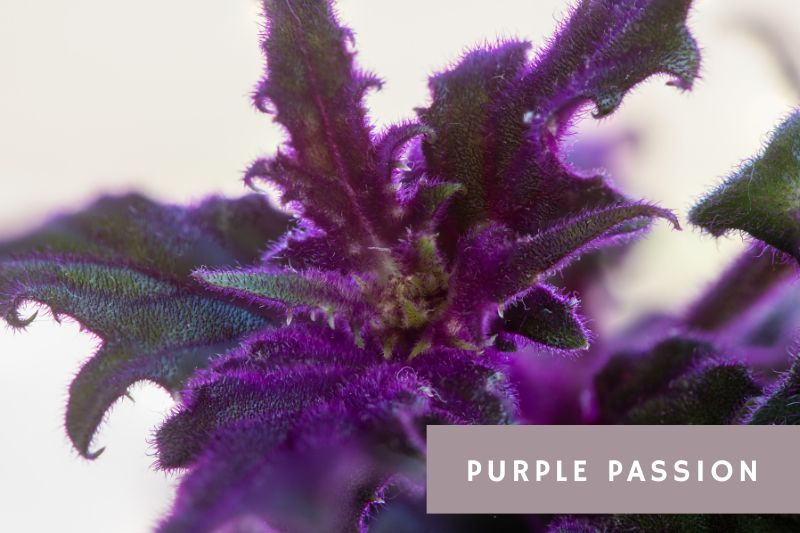
Purple Passion
Purple Passion delights with its soft, velvety leaves in vivid violet, each fuzzy blade adding a plush, tactile layer to your indoor collection. The trailing stems reveal hints of green at the nodes, creating a subtle two-tone effect.
This clumping perennial grows steadily into a low mound, sending out arching shoots that cascade gently over pot edges. As a monocarpic plant, it will eventually bloom, forming a spray of tiny yellow flowers before its foliage declines—but not before years of plush growth.
Keep this beauty in bright, indirect light and evenly moist, well-drained soil. Aim to mist occasionally or set on a humidity tray to maintain leaf softness. Feed monthly during the growing season to support that lush, velvety texture.
Key Features:
- Velvety purple leaves
- Cascading growth habit
- Monocarpic lifecycle
- Stinky blooms
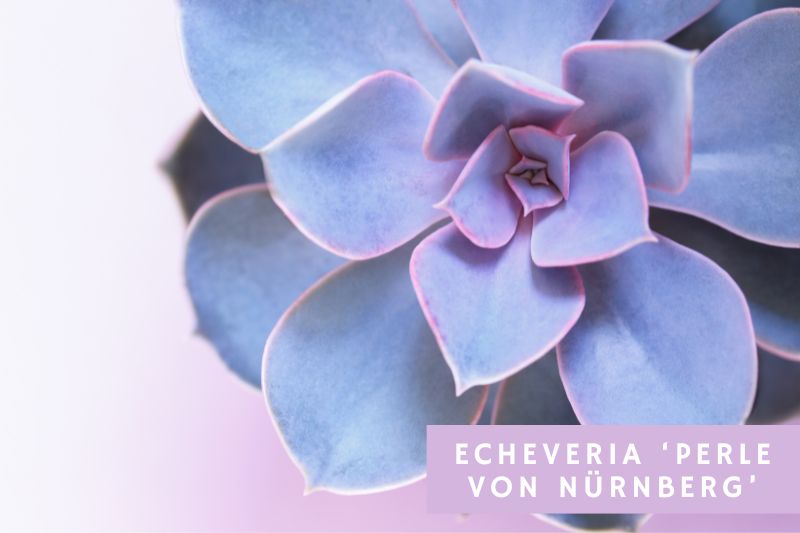
Echeveria ‘Perle von Nürnberg’
Echeveria ‘Perle von Nürnberg’ dazzles with its neat rosette of silver-green leaves edged in lavender—an elegant focal point on a sunny windowsill or patio.
In summer, this hardy succulent sends up tall stalks of bell-shaped pink flowers that stand beautifully above its leaf crown. Between blooms, its compact rosette holds tight, showing off those delicate purple margins.
Give it at least six hours of bright light—morning sun is ideal—and water deeply only when the soil is bone dry (every 2–3 weeks). It tolerates brief cold snaps (down to about 25°F) but thrives best in warmth and good airflow.
Key Features:
- Lavender-edged rosette
- Pink summer blooms
- Drought-tolerant
- Cold-tolerant to 25°F
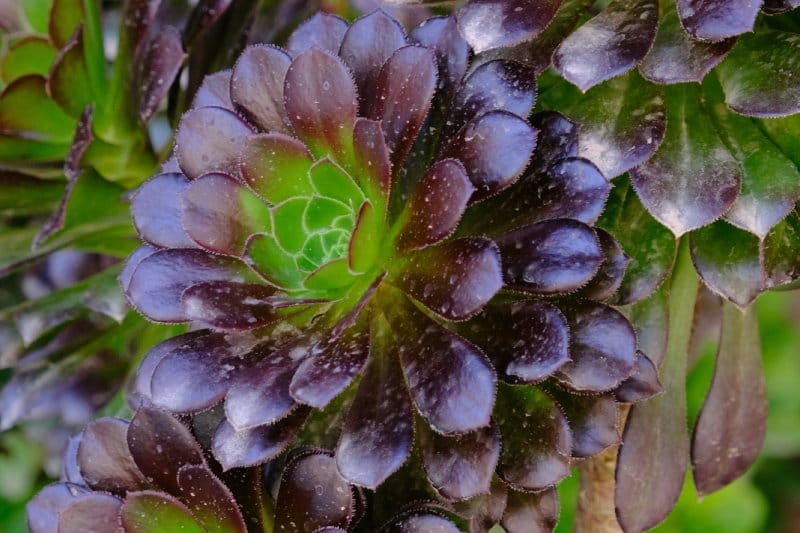
Black Rose Aeonium
Black Rose Aeonium forms dramatic, flat rosettes of glossy purple leaves that fade to vivid emerald at the center—an unbeatable focal point in any bright spot.
As a semi-succulent shrub, it grows on sturdy stems, producing tiered rosettes that catch the light and reveal that glowing green heart. Give it 6+ hours of direct sun to deepen its purple tones.
This drought-tolerant beauty needs a well-draining mix and a soak-and-dry watering cycle—water only when the soil is bone-dry (about every 2–3 weeks). Protect from frost and watch it reward you with sculptural form.
Key Features:
- Glossy purple rosettes
- Full sun lover
- Sturdy branching habit
- Drought-tolerant care
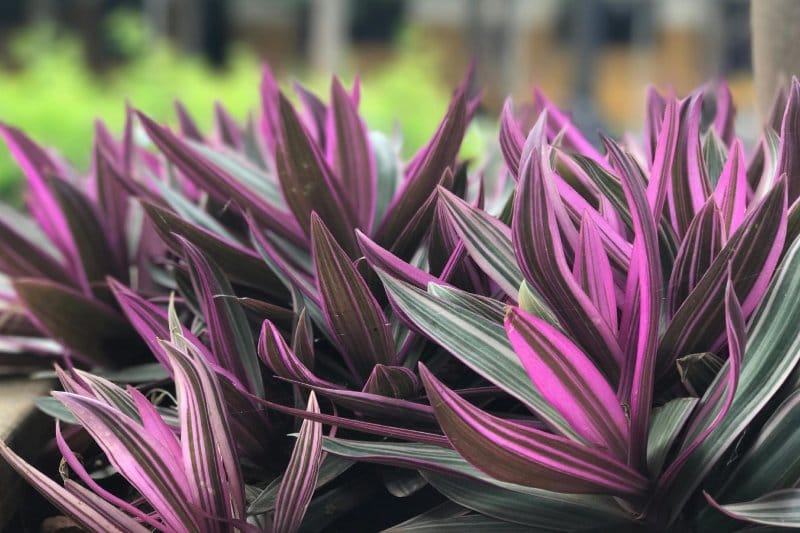
Moses-in-the-Cradle
Moses-in-the-Cradle is a true purple and green leaf plant, its lance-shaped leaves glossy green on top and vivid magenta-purple underneath—an eye-catching surprise in any corner.
This easy-going rhizome grower forms tight rosettes that spill into trailing runners, perfect for a hanging basket or as groundcover in a bright spot. You’ll love watching new shoots push up green, then blush purple as they mature.
Treat it like other indoor plants with purple and green leaves: give bright, indirect light, water when the top inch of soil dries (about once a week), and mist occasionally to keep its foliage lush.
Key Features:
- Boat-shaped foliage
- Purple underside sheen
- Trailing basket habit
- Humidity friendly
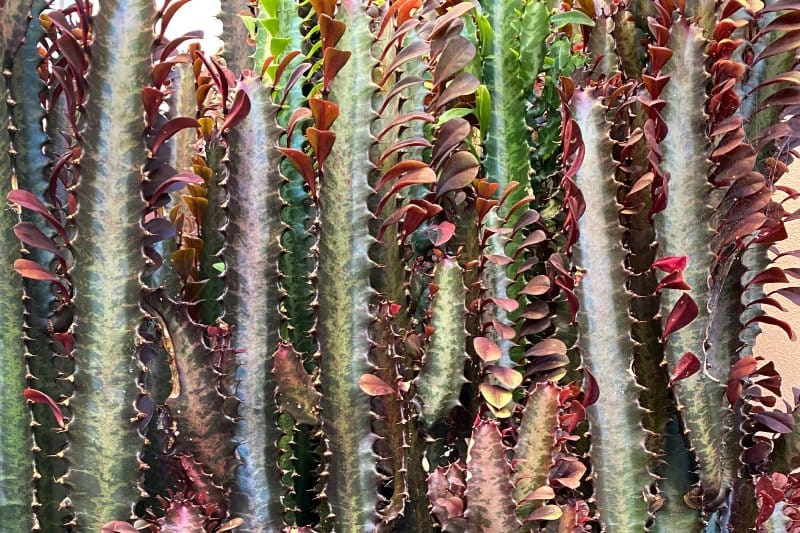
African Milk Tree ‘Rubra’
The African Milk Tree ‘Rubra’ is an architectural showpiece, its upright, candelabra-style stems flush with deep green fading to burgundy-red under bright sun—an instant sculptural focal point.
This succulent shrub sports paired thorns and occasional small leaves along its ridges, slowly branching upward to create a dramatic vertical accent. In strong light, those stems glow with purple-red highlights.
Treat it like other sun-loving succulents: give at least 6 hours of direct sun, plant in a fast-draining cactus mix, and water only when the top 2–3 inches of soil are completely dry (roughly every 3–4 weeks).
Key Features:
- Sculptural columnar stems
- Sun-flushed purple tints
- Paired thorn accents
- Full-sun lover
Conclusion
That wraps up our lineup of purple-and-green leaf houseplants—whether you’re after a carefree trailer like Wandering Dude or a more hands-on beauty like Rose Painted Calathea, there’s a perfect match for every skill level and style.
Ready for more color adventures? Dive into our guides on shadowy black-leaved plants for a gothic twist, fiery red-and-green varieties for warmth, or soft pink-leafed beauties to round out your collection.
No matter your experience, we’ve got the city-friendly tips you need to keep your leafy roommates happy—and your home bursting with vibrant hues.

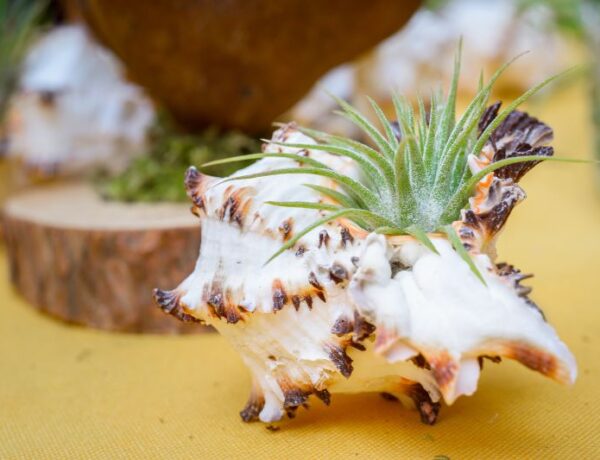
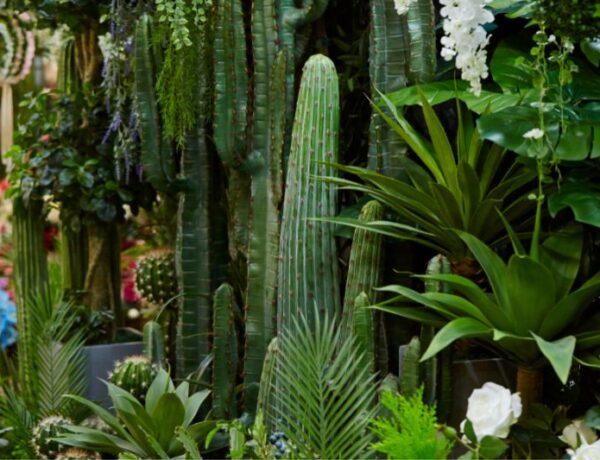
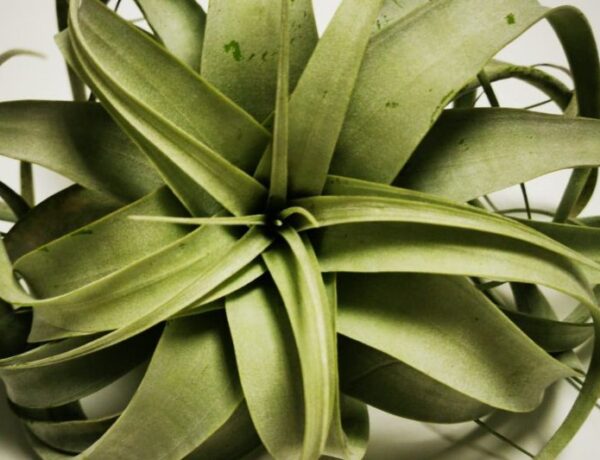


No Comments